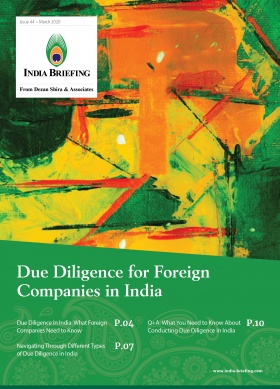Karnataka’s New Industrial Policy for 2020-25: What Should India-Bound Foreign Investors Expect
As Tesla looks to set up an assembly plant in the state, with a fully-owned subsidiary incorporated in Bengaluru in January this year, we examine Karnataka’s new industrial policy incentives. The state wants to attract high-tech investments and move industrial and technology hubs beyond the state capital, Bengaluru (formerly, Bangalore).
Last year, on July 23, the state cabinet of the Karnataka government approved the New Industrial Policy for 2020-25.
The policy was unveiled at a sensitive time for the south Indian state given the impact of COVID-19 and the need for a clear strategy to attract investment, create jobs, and incentivize industrial growth.
Overall, the new industrial policy seeks to attract investments worth INR 5 trillion (approx. US$66.89 billion). The sectors encouraged include automobiles and auto components, pharmaceuticals, medical devices, knowledge-based industries, electric vehicles, and logistics, among others.
What is the focus of Karnataka’s new industrial policy?
The new policy will facilitate greater investments in advanced manufacturing, research and development (R&D), and innovation and aims to the create at least 2 million jobs.
In his pitch to the press, State Minister for Large and Medium Scale Industries and Public Enterprises, Jagadish Shettar, explained that the new industrial policy intended to promote the development of tier-2 and tier-3 cities in Karnataka, pivot the state to rank third in merchandise exports in the next five years, and maintain a yearly industrial growth rate of 10 percent.
The policy will be “pro-industry and aligned with recent reforms, such as amendments to the Land Reforms Act, the Labour Act, and Karnataka Industries (Facilitation) (Amendment) Act. The New Industrial Policy for 2020-25 will oversee new incentives and an easing of the regulatory process.”
In terms of the kind of investments the state sought to attract, Shettar said: “To emerge as globally competitive with skill and scale that leverage hi-tech growth, following thrust areas have been recognized: Industry 4.0, Research and Development, Intellectual Property Rights (IPR), Technology Adoption and Innovation, Cluster Development Initiatives and Sustainable Industrialization.”
Highlights of the policy
Moving beyond the capital, Bengaluru: The new industrial policy groups Karnataka’s districts into three zones to develop areas considered to be industrially backward. The industrially backward districts come under Zone-1 and Zone-2 while more industrially developed districts are classified under Zone-3 and Zone-4. Urban centers Bengaluru and Mysuru (formerly Mysore) come under Zone-4. Incentives will be rolled out to direct greater investment to the industrially backward districts.
Sector focus of the policy: Key focus sectors have been identified under the policy – automobiles and auto components, pharmaceuticals, medical devices, engineering and machine tools, knowledge-based industries, logistics, renewable energy, aerospace, defense, and electric vehicles.
Special investment regions in Dharwad and Shivamogga: The policy aims to enact the Special Investment Region (SIR) Act to create, operate, and regulate such investment regions in the state. Special investment regions would have an area of about 100 sq.km and be categorized as industrial townships. The first such region or SIR will encompass the Dharwad, Gadag, Haveri, and Belagavi districts of Karnataka. Another SIR that is being planned includes Shivamogga, Davanagere, Chitradurga, and Chickamagaluru districts as well as Kalaburagi, which is in the Kalyana Karnataka district (previously known as Hyderabad-Karnataka region).
Subsidies for MSMEs: The policy offers production turnover-based subsidies for micro, small, and medium-sized enterprises (MSMEs) with a view to boost industrial innovation. The investment promotion subsidy will be based on 10 percent on turnover each year for a period of five years and limited to 20 to 30 percent of value of fixed assets (VFA). Other incentives include – exemption from stamp duty and concessional registration charges; reimbursement of land conversion fee; tax exemption on electricity tariff for MSMEs; and power subsidy for MSMEs. (More in the section below.)
Local jobs creation: The policy will require new industrial projects to create as much direct employment as possible and hire locally – a minimum of 70 percent of the workforce should consist of locals and 100 percent in the case of Group D type of employees (housekeeping and sanitation staff, non-technical posts, drivers, etc.). The draft version of the policy mandated the minimum direct employment for 100 employees for the initial investment of INR 2.5 billion (US$33.39 million) and additional employment of 20 personnel for every additional investment of INR 500 million (US$6.67 million).
Labor reforms under the policy: An amendment to the Factories Act, 1948 will ensure that women workers who work the night shift in factories, that is between 7pm to 6am, are registered. Sections 64 and 65 of the Factories Act have been amended to extend overtime hours to 125 hours per quarter. The Industrial Employment (Standing Order) Act, 1946 has been amended to permit fixed term employment or contract employment. The amended Rules were notified on June 30, 2020.
Wage revisions: The minimum wage will be periodically revised based on factors like inflation and consumer price index (CPI).
How will enterprises qualify for incentives?
The New Industrial Policy 2020-25 outlines investment promotion subsidies for enterprises according to their scale of production, turnover, and whether they are operated by persons belonging to special categories.
Investment promotion subsidies
For micro enterprises – investment promotion subsidies of up to 30 percent of VFA will be offered in Zone-1, 25 percent of VFA in Zone-2, and 15 percent VFA in Zone-3.
For enterprises run by persons belonging to a special category – women, members of the Dalit and Adivasi communities, ex-servicepersons, members from minority communities, and persons with disabilities – there are separate incentives. For those eligible for special category incentives, they will qualify for investment promotion subsidies worth 35 percent of VFA in Zone-1, 30 percent of VFA in Zone-2, 20 percent in Zone-3, and 10 percent in Zone-4.
For large enterprises with investment on fixed assets between INR 100 million (US$1.33 million) and INR 2.5 billion (US$33.39 million), the policy offers an investment promotion subsidy based on their turnover. The priority is once again given to enterprises in Zones-1, 2, and 3. In Zone-1, 65 percent of VFA will be offered for a turnover rate of 2.75 percent for a period of seven years. In Zone-2, it is 55 percent VFA for 2.5 percent turnover for six years and 45 percent VFA for large enterprises in Zone-3 showing a 2.5 percent turnover rate.
Interest subsidy on loans
The policy also stipulates that MSMEs qualify for interest subsidy on technology upgradation loans of up to 10 percent for a period of five years. These concessions are not applicable to loans obtained from the Karnataka State Financial Corporation and commercial banks that are not listed under the credit linked capital subsidy scheme of the government of India.
Micro and small enterprises will be offered interest subsidies if they secure loans from public service banks at an annual rate of three percent for five years.
Stamp duty concessions
Depending on the zone where they are based, MSMEs can be exempted from stamp duty on land registration. The policy waives 100 percent stamp duty for enterprises in Zones-1 and 2 and 75 percent of the stamp duty in Zone-3.
For enterprises operated by persons qualifying for special category incentives, a 100 percent concession of stamp duty is available in Zones-1, 2, and 3 and a 75 percent concession in Zone-4. The land conversion fee can be reimbursed up to 100 percent for enterprises in Zones-1 and 2 and 75 percent for those in Zone-3.
Tax exemptions on electricity tariffs
MSMEs will also be offered a 100 percent exemption from tax on power tariffs for a period of seven years in Zone-1, six years in Zone-2, and five years in Zone-3. Micro and small enterprises can avail reimbursement of power tariffs at the rate of INR 1 per unit for a period of three years.
Other subsidies
Additionally, MSMEs can access subsidies for sustainable operations strategies, such as setting up rainwater harvesting systems and wastewater management and get reimbursed for expenses on conducting a water audit and recycling their electronic and plastic waste.
In addition, subsidies will be offered for enterprises that set up effluent treatment plants within their premises.
What is the investment appeal of Karnataka?
Karnataka amended the Karnataka Industrial (Facilitation) Act in 2020 and launched an affidavit-based approval system (ABAS) on December 21, 2020, which will allow eligible private sector investors to set up a business in Karnataka without requiring multiple clearances for the first three years of establishment. The state government also amended Section 109 of the Karnataka Land Reforms Act to enable easier acquisition of agricultural land for industrial purposes. (For more information, see Karnataka’s New Approval System and Ease of Doing Business Reforms.)
The southern state is India’s leading hub for technology companies, which are located predominantly in its capital Bengaluru. Karnataka is also a popular destination for auto, electronics, food processing, heavy machinery, and the textiles industry.
The state is India’s largest software exporter, largest producer of aerospace and defense equipment, has the largest biotech hub, and is the largest producer of coffee in the country. Karnataka also hosts the highest number of R&D centers, technical and medical institutions, and startup enterprises in India.
On January 8, 2021, US-based electric and clean energy company Tesla incorporated its fully-owned subsidiary at Bengaluru with plans to set up an R&D office in the city. According to public record, the company was registered with an authorized capital of INR 1.5 million (US$20,546) and a paid-up capital of INR 100,000 (US$1,369). Tesla is also in talks with the state government to open an assembly plant at Dharwad in north Karnataka.
Overall, Karnataka stands fourth in merchandise exports in the national export basket. Exports from the state stood at around US$17.4 billion in 2018-19, which is 5.3 percent of India’s total exports. The state ranked third among Indian states in terms of foreign direct investment (FDI) inflows, attracting FDI worth US$40.7 billion between 2000 and 2019. Meanwhile, Bengaluru has been ranked the fourth-best city for investment in India.
Karnataka is well connected to all major markets with two international airports; 307,030 km of road network; and 5,543 km rail network. The state has a coastline of 300 km with 12 minor ports and one major port in Mangaluru (formerly Mangalore). The Bengaluru-Mumbai Economic Corridor and Chennai-Bengaluru Industrial Corridor pass through Karnataka. The state is home to the Pavagada Solar Park, which has an installed capacity of 2,000 MW, the largest in the country, of which 1,400 MW is operational. The total installed power capacity in Karnataka stands at 28,400 MW.
For more information and advice on choosing the right location for your business in India, please email us at india@dezshira.com.
This article was originally published on July 28, 2020. It was last updated January 15, 2021.
About Us
India Briefing is produced by Dezan Shira & Associates. The firm assists foreign investors throughout Asia from offices across the world, including in Delhi and Mumbai. Readers may write to india@dezshira.com for business support in India.
- Previous Article India-EAEU FTA Appears in Sight, Moscow Signals Support
- Next Article An Introduction to Doing Business in India 2021 – New Publication from Dezan Shira & Associates








